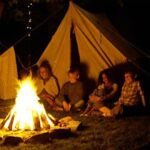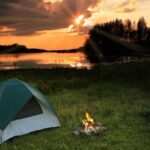Select a sleeping bag filled with down or with one of the tried-and-true synthetic fills such as Hollofil II, Polarguard HV, or Lite Loft. Sleeping bags for spring and fall use should be rated as a three-season bag, or designed for use in temperatures as low as 20° F. Summer-weight sleeping bags are rated for use in temperatures above the freezing point.
Don’t Wear Cottons in Cold Weather
Don’t wear cotton in cold weather. Cotton gets wet easily and stays that way while causing your body temperature to drop. It has no insulating value and when it gets wet it can be dangerous in cold conditions. Blue jeans, which are made of cotton, are terrible camping clothes when it’s chilly. Choose wool or one of the popular synthetics instead.
Layering Clothes for Winter Camping
In addition to bringing a good sleeping bag, dress in layers. As the day gets progressively colder, don more outerwear to combat chilly temperatures. The proverbial happy campers are those who dress in three layers of clothing:
- An inner layer (the underwear) should be made of polypropylene and polyester in different weights. This keeps moisture (sweat) away from your skin to keep you dry.
- A mid-layer of wool (or synthetic) should fit comfortablynot too tight, not too loose. This insulates or traps air between you and the outer layer.
- A third, synthetic outer layer is needed as a wind shell. It blocks the wind and keeps you dry as well.
If your camping takes place in wet conditions, choose a shell made from Gore-Texa breathable, waterproof fabric that offers protection from wind and rain.
Positioning Your Tent for Cold Weather
Winds generally blow upslope during the day and downslope by night. Position a tent so that openings don’t face a slope or significantly higher ground. Colder, dense air settles in low-lying ground like meadows. Choose a campsite that is situated on higher ground, which some trees or other natural cover.



